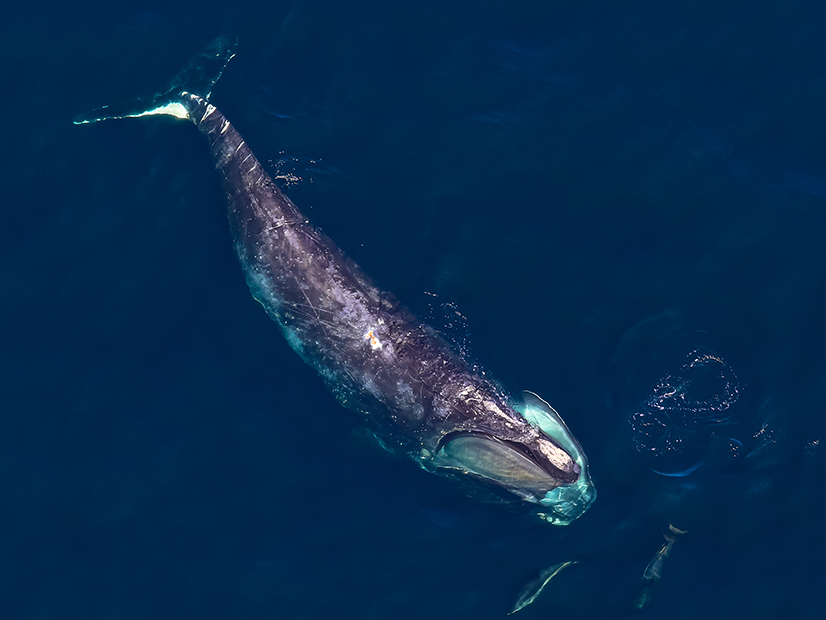
A new report finds that the impact of offshore wind development on an endangered whale species in a key ecosystem will be hard to distinguish from the ongoing impacts of climate change.
The report looks at the Nantucket Shoals, a unique shallow area southeast of Massachusetts that supports an aggregation of the zooplankton consumed by the ton by the North Atlantic Right Whale, which migrates there to feed.
Nine federal wind lease areas are clustered in 900,000 acres just west of the shoals; two utility-scale wind farms are being built there now, and several others are in varying stages of development.
Full buildout would entail up to 700 turbines in a grid pattern across the area.
One of the regular talking points of offshore wind opponents is the effect of offshore wind power on the rare leviathans, roughly 340 of which are believed to remain in the world. Offshore wind opponents often focus on the risk of whales being struck by ships or harmed by construction noise, but the new report focuses instead on a more subtle effect: hydrodynamics — the structure and movement of ocean water — and how it would affect the ecosystem there.
“Potential Hydrodynamic Impacts of Offshore Wind Energy on Nantucket Shoals Regional Ecology: An Evaluation from Wind to Whales” was sponsored by the Bureau of Ocean Energy Management and compiled by the National Academies of Sciences, Engineering and Medicine.
Offshore wind development is new to the United States, so there is no domestic data from which to estimate its impacts on the shoals. Modeling limited data from North Sea wind farms suggests offshore wind can modify water circulation and ecology, the authors write, and the impacts can extend beyond the region of the wind farm.
But the North Sea is different from the U.S. Outer Continental Shelf.
The shallow area south of Nantucket already is known for its complex hydrodynamics and ecology, even before the first wind turbines start spinning: It can contain warm eddies that break off the Gulf Stream, bottom friction, tidal mixing and stratification.
It is the site of numerous shipwrecks, as well. For decades, lightships were stationed on the south edge of the shoals.
Copepods thrive there. A cubic meter of water can contain more than 100 of each of several of the tiny zooplankton species during the springtime peak. The North Atlantic Right Whale eats a few thousand pounds of zooplankton per day, and nothing else.
A decade of surveys found the whales’ presence increasing in both the shoals and the wind energy areas, but this may be due to the zooplankton concentration increasing there or decreasing in other feeding areas.
Precautions are in place to protect whales and other large sea mammals from injury during construction of the Vineyard and South Fork wind projects, and they would presumably be imposed during future projects not yet approved.
When construction is complete, the more subtle effects addressed in the report would begin: Dozens of monopile foundations would create underwater wakes and dozens of rotors up to 900 feet in diameter would create concentrated wind wakes above the water.
Zooplankton could increase or decrease in productivity or concentration as a result, to the benefit or detriment to the whales that eat it. Or there might be no effect at all.
The complicating factor is that the baseline against which these effects will be measured is itself moving, because of the naturally shifting character of the shoals from one decade to the next and the effects of human-induced climate change.
The fishing industry and others concerned about ocean ecology have been unhappy that offshore wind development is progressing so ambitiously with such large gaps in knowledge about its impacts.
“The studies available about the effects and implications of wind farms on local ecosystems are not sufficient to say with absolute certainty whether the turbines would have effects on specific parts of the Nantucket Shoals ecology,” said Eileen Hofmann, a professor and eminent scholar in the department of ocean and earth sciences at Old Dominion University who chaired the report committee.
“But with everything we do know at this time, we conclude that those effects are difficult to compare to the impacts of all the other forces changing the hydrology in the region already, especially with the existing and future effects of climate change. Research and monitoring will be essential as these projects move forward in the Nantucket Shoals and other areas around the globe.”
The report recommended further observation during construction and continuing all the way through the operation and decommissioning phases.

